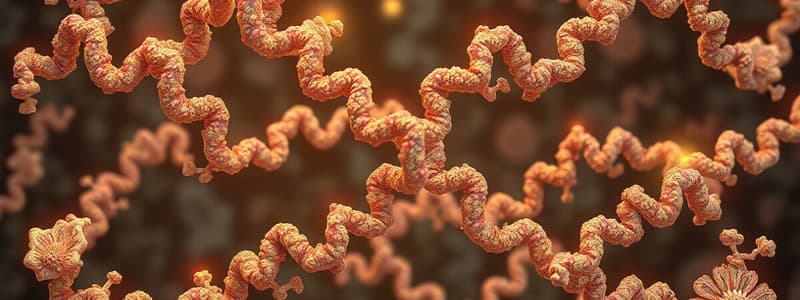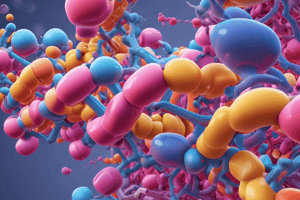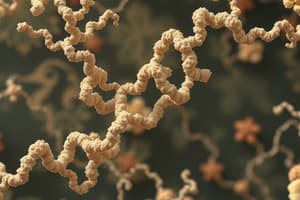Podcast
Questions and Answers
What is the average number of amino acids found in one alpha helix within a globular protein?
What is the average number of amino acids found in one alpha helix within a globular protein?
- 2-15
- 6
- 53
- 11 (correct)
Which of the following amino acids is most likely to be found on the surface of a globular protein, interacting with water molecules?
Which of the following amino acids is most likely to be found on the surface of a globular protein, interacting with water molecules?
- Methionine
- Leucine
- Glutamic Acid (correct)
- Valine
Which of the following statements is TRUE about the beta-pleated sheet structure?
Which of the following statements is TRUE about the beta-pleated sheet structure?
- It is held together by hydrogen bonds between neighboring peptide bonds. (correct)
- It is found only in fibrous proteins.
- It has a slight left-handed twist.
- It is always made up of parallel strands.
What is a domain in a protein?
What is a domain in a protein?
Which of the following proteins has a high percentage of alpha helix structure?
Which of the following proteins has a high percentage of alpha helix structure?
What is the difference between a dimer and a tetramer?
What is the difference between a dimer and a tetramer?
Which of the following is an example of a protein with a quaternary structure?
Which of the following is an example of a protein with a quaternary structure?
Which type of amino acid is MOST LIKELY to be found in the interior of a globular protein?
Which type of amino acid is MOST LIKELY to be found in the interior of a globular protein?
Which of the following statements about keratin is incorrect?
Which of the following statements about keratin is incorrect?
What is the main structural component of hair?
What is the main structural component of hair?
Which of the following statements about collagen is correct?
Which of the following statements about collagen is correct?
What is the significance of disulfide bridges in keratin?
What is the significance of disulfide bridges in keratin?
What is the role of molecular chaperones in protein folding?
What is the role of molecular chaperones in protein folding?
Why is the structure of protofilaments in keratin stable?
Why is the structure of protofilaments in keratin stable?
The central dogma of protein folding states that:
The central dogma of protein folding states that:
Which of the following statements is true about the protein folding process?
Which of the following statements is true about the protein folding process?
Which of the following statements is TRUE about the structure of myoglobin?
Which of the following statements is TRUE about the structure of myoglobin?
Which of the following amino acids is NOT found in the interior of myoglobin?
Which of the following amino acids is NOT found in the interior of myoglobin?
Which of the following statements correctly describes the heme group in hemoglobin?
Which of the following statements correctly describes the heme group in hemoglobin?
How many subunits does hemoglobin have, and how many oxygen molecules can it bind?
How many subunits does hemoglobin have, and how many oxygen molecules can it bind?
What is the difference between the relaxed (R) and tense (T) structures of hemoglobin?
What is the difference between the relaxed (R) and tense (T) structures of hemoglobin?
What is the primary function of hemoglobin in the blood?
What is the primary function of hemoglobin in the blood?
What causes the change between the T and R structures of hemoglobin?
What causes the change between the T and R structures of hemoglobin?
Which of the following statements is TRUE about the α-subunits of hemoglobin?
Which of the following statements is TRUE about the α-subunits of hemoglobin?
Flashcards
Alpha Helix
Alpha Helix
A helical structure in proteins formed by hydrogen bonds between peptide bonds.
Beta Structure
Beta Structure
A secondary structure in proteins formed by hydrogen bonds, resulting in pleated sheets.
Parallel Beta Sheets
Parallel Beta Sheets
Beta structure where chains run in the same direction, stabilizing the sheet.
Anti-parallel Beta Sheets
Anti-parallel Beta Sheets
Signup and view all the flashcards
Globular Proteins
Globular Proteins
Signup and view all the flashcards
Protein Domains
Protein Domains
Signup and view all the flashcards
Quaternary Structure
Quaternary Structure
Signup and view all the flashcards
Oligomeric Proteins
Oligomeric Proteins
Signup and view all the flashcards
Hemoglobin Structure
Hemoglobin Structure
Signup and view all the flashcards
Central Dogma of Protein Folding
Central Dogma of Protein Folding
Signup and view all the flashcards
Protein Folding Process
Protein Folding Process
Signup and view all the flashcards
Molecular Chaperones
Molecular Chaperones
Signup and view all the flashcards
Keratin
Keratin
Signup and view all the flashcards
Collagen
Collagen
Signup and view all the flashcards
Myoglobin Discovery
Myoglobin Discovery
Signup and view all the flashcards
Fibrils Formation
Fibrils Formation
Signup and view all the flashcards
Myoglobin
Myoglobin
Signup and view all the flashcards
Heme Group
Heme Group
Signup and view all the flashcards
Structure of Myoglobin
Structure of Myoglobin
Signup and view all the flashcards
Hemoglobin
Hemoglobin
Signup and view all the flashcards
Oxygen Binding in Hemoglobin
Oxygen Binding in Hemoglobin
Signup and view all the flashcards
Tense vs. Relaxed Structure
Tense vs. Relaxed Structure
Signup and view all the flashcards
Rotation between Subunits
Rotation between Subunits
Signup and view all the flashcards
Iron in Heme
Iron in Heme
Signup and view all the flashcards
Study Notes
Protein Structure
- Proteins are large, complex molecules vital for numerous cellular functions.
- Their function hinges on their specific three-dimensional shape.
- The sequence of amino acids in a polypeptide chain determines the protein's overall structure.
Forces Influencing Protein Structure
- Hydrogen bonds form between peptide groups in the protein backbone.
- Hydrogen bonds form between side chains.
- Hydrophobic interactions occur between non-polar side chains.
- Hydrophilic interactions occur between polar side chains.
- Ionic bonds form between oppositely charged side chains.
- Disulfide bonds link cysteine side chains.
Secondary Structures
- Alpha-helix: A predominantly right-handed helical structure stabilized by hydrogen bonds between the N-H group of one peptide bond and the C=O group of another, typically four amino acids apart.
- Average amino acids per helix is around 11, though this can vary up to 53.
- Beta-sheet: A pleated sheet structure in which multiple β-strands are arranged parallel or anti-parallel. Hydrogen bonds between the polypeptide backbone of adjacent strands stabilize the structure.
- Parallel and anti-parallel beta strands are two possible variations.
- Average amino acids per sheet is between 2-15, with an average of 6.
Tertiary Structures
- The overall 3D structure of a polypeptide chain.
- The arrangement of secondary structures.
- Proteins often contain hydrophobic amino acids nestled inside the folded structure and hydrophilic amino acids on the outside, to facilitate water solubility.
- Myoglobin and hemoglobin are examples of proteins with a predominant alpha-helical structure and a compact shape.
- Concanavalin A is an example of a protein with predominantly beta-sheet structure.
- Supersecondary structures/motifs are formed by combinations of secondary structures.
Quaternary Structures
- The structure resulting from the interaction of multiple polypeptide chains.
- Proteins with more than one polypeptide chain are called oligomeric.
- Individual chains within an oligomeric structure are called subunits or monomers.
- Examples: Haemoglobin, Myoglobin, Muscle creatine kinase.
Central Dogma of Protein Folding
- Primary structure dictates the tertiary structure.
- Protein folding is a spontaneous process.
- Local secondary structures form a nucleus, around which the rest of the protein folds.
- Molecular chaperones aid protein folding, especially under stress conditions.
Selected Protein Structures
- Fibrous Proteins:
- Primarily structural proteins.
- Examples: Keratin, Collagen, Silk.
- Globular Proteins:
- Perform metabolic functions including transport, catalysis (e.g., enzymes), hormone function.
- Examples: Myoglobin, Hemoglobin.
Denaturing Proteins
- Proteins denature when bonds maintaining their shape are broken.
- Temperature, pH, or salt concentration changes can cause denaturation.
- Denatured proteins lose function and often become insoluble.
- Fibrous Proteins: lose structural strength when denatured
- Globular Proteins: become insoluble and inactive.
Myoglobin
- Myoglobin's structure was determined through x-ray crystallography.
- Contains 153 amino acids with 75% in alpha-helix and 8 helix segments (A to H).
- Its compact shape facilitates oxygen binding.
- It has a prosthetic group, haem, essential for oxygen transport
Hemoglobin
- Haemoglobin is a critical oxygen-transport protein.
- It has four protein chains (2 alpha and 2 beta). Each subunit can carry one oxygen molecule, making its capacity to carry oxygen high.
- Each subunit has 7-8 helical segments like myoglobin.
- Its quaternary structure enables cooperative oxygen binding and release.
- Haemoglobin has different conformations (R and T states) related to oxygen binding affinity.
- Changes in haemoglobin structure cause conditions like sickle-cell anemia.
Differences between Collagen and Haemoglobin
| Feature | Collagen | Haemoglobin |
|---|---|---|
| Polypeptide Chains | Not identical; 3 | Identical; 4 |
| Prosthetic Group | No | Yes (Haeme) |
| Structure | Fibrous | Globular |
| Tertiary Structure | No | Yes |
| Repeating Amino Acids | Glycine | Less glycine, varies |
Studying That Suits You
Use AI to generate personalized quizzes and flashcards to suit your learning preferences.




